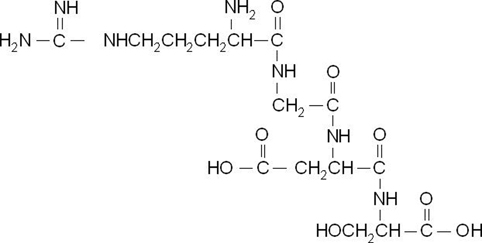| Name
|
Arg-Gly-Asp-Ser
|
| Other Name
|
RGDS
|
| Sequence (Single letter abbreviations)
|
RGDS
|
| Sequence(Three letter abbreviations)
|
{ARG}{GLY}{ASP}{SER}
|
| Basic description
|
R-G-D-S, Arg-Gly-Asp-Ser, supports fibroblast attachment and inhibits fibronectin binding to platelets. It is the target sequence for syphilis spirochete adherence. RGDS increases ILK activity and the tyrosine phosphorylation of HMC proteins as well. In the case of tyrosine kinases, similar effects have been demonstrated in other cell types whereas the involvement of ILK, a serine-threonine kinase, in RGD effects has been less studied. To test the relevance of these two types of kinases in the stimulation of TGF-ß1 synthesis by RGDS, activities were blocked by pharmacological or transfection means.
|
| Solubility
|
This peptide is soluble in water. The contents of this vial have been accurately determined. Both the stopper and the vial have been siliconized. Do not attempt to weigh out a smaller portion of the contents.
|
| The molecular weight
|
433.420
|
| Chemical formula
|
C15H27N7O8
|
| The purity
|
> 95%
|
| Storage conditions
|
Store the peptide at -20°C. Keep container tightly closed.
|
| Annotation
|
Exhibits cell attachment promoting activity
|
| Documents
|

|
| Figures
|

|
| Reference
|
Mineur P, et al. RGDS and DGEA-induced [Ca2+]i signalling in human dermal fibroblasts. Biochim. Biophys. Acta. Oct 2005; 1746(1): 28-37.
DeLong SA, et al. Covalent immobilization of RGDS on hydrogel surfaces to direct cell alignment and migration. J. Control Release. Dec 2005; 109(1-3): 139-148.
Hou RZ, et al. Alcalase-catalyzed, kinetically controlled synthesis of a precursor dipeptide of RGDS in organic solvents. Prep. Biochem. Biotechnol. 2006; 36(1): 93-105.
Hanjaya-Putra D., et al. Integration and Regression of Implanted Engineered Human Vascular Networks During Deep Wound Healing. Stem Cells Transl Med. 2013 Apr;2(4):297 - 306.
Donny Hanjaya-Putra., et al. Controlled activation of morphogenesis to generate a functional human microvasculature in a synthetic matrix. Blood. 2011 Jul;118(3):804 - 815.
|
